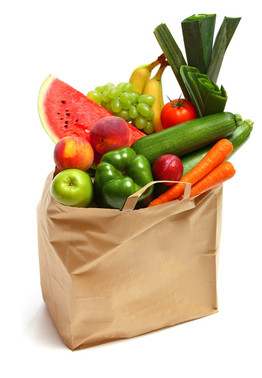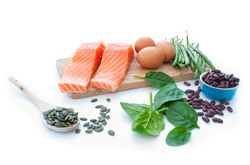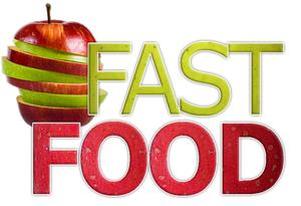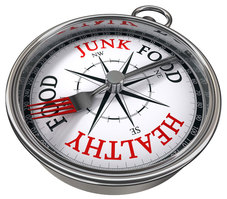 I gave a nutrition and fitness talk last week and the question came up about the cost of eating healthy. I love to answer that question. The real question might be to ask, “What is the cost of not eating healthy?” I will let you think about that one to create meaning around that for yourself. For these purposes, I am going to focus on what I shared with this audience. That is to say that this statement in general, is a myth. I shared the example of the cost of green beans as measured by cost per serving. To illustrate this point for you, I pulled the chart from a USDA resource. Green beans are a healthy and whole food. Let me show you how they measure. Green beans—Average retail price per pound and per cup equivalent, 2013 Form Ave. retail price Size of a cup equivalent Ave. price/cup equiv. Fresh $2.14 per lb. 0.276 lbs. $0.70 Frozen $1.67 per lb. 0.298 lbs. $0.55 In general, this cost is not more than processed foods, and green beans offer so much more nutritionally than what you might find in a packaged bar. Let’s say you want to have green beans, grilled chicken and farro for dinner tonight. Maybe even a small spinach salad to go with that. That may sound like a lot of food, but per serving, it makes a really healthy and cost efficient meal. Also, you can prepare your own dressings and marinades with olive oil and lemon, etc… I estimate this meal to cost no more than $5.00-$6.00 per serving for a family of 4.
…and then you have leftover of spinach and farro leftover and possibly some leftover chicken that you can make tortilla soup with. The cost to prepare tortilla soup is about as much as two cans of chicken broth, a large can of whole tomatoes, celery, onion, avocado, some cheese if you have it, and some crumbled chips if you have them…so what do you think?….about $2 or $2.50 per serving? That is two meals for a family of four at $7 per person or $3.50 per person each meal. The real cost is your time. You have to shop, plan and prepare foods, cook and clean up. The key to success for time, money and health savings is planning and prepping. Luckily, grocery stores prep many fresh foods for us and for that we pay premium. If you find yourself throwing out fresh veggies that spent too much time in your fridge wilting, then it might be worth the extra penny to purchase the already prepped veggies. Another method, and the one that I adhere to is to “always be prepping”. When I come home from grocery shopping, I put most groceries away and immediately start cutting up or peeling fruit and veggies to have those ready and available for meals. I also start preparing my “go to” foods then. A few thoughts on planning ad preparing cost efficient healthy meals for the busy person that you are:
Consider how much you spend on real food vs. packaged food and you may discover that it isn’t the real food that we are spending our money on. © Health Inspires.
0 Comments
 Beach!! I intentionally loaded up on several snacks and treats at the grocery store for our last year’s summer beach vacation. It was fun to treat our kids with fun snacks they do not typically get at home. As much as I was enjoying the moment and some of the snacks myself, I couldn’t resist the urge to say something. It was about the second day when I realized every box or bag was open and I finally said, ”How much junk are we going to eat?” in my half playful voice, which means the other half of my voice was expressing alarm. One of our boys shrugged his shoulders and matter of factly said, “I don’t know…as much as we have.” He nailed it! Are your children as smart as mine?! Of course they are. Kids simplify and say it like it is. As a matter of fact, studies show, the more food choices you have, the more you will eat. In addition, the more convenient a food is to take with you, the more you will eat. There are processed and packaged foods everywhere. The sooner we start grabbing an apple for a snack instead of a package of something junky, the better off we will be. As a matter of fact, I feel confident to say if you bring a packaged bar of some sort with you to work, you will eat it regardless. If you bring an apple, for example, you will eat it only if you are hungry. Can anybody relate to this? I want you to avoid processed foods. I will share 7 ingredients you should avoid, and give you good reasons why. By reading the ingredients panel on every food you consider putting in your basket and avoiding these 7 ingredients, you will naturally eliminate many processed foods from your pantry and fridge. At the very least, it will help you make better choices.
The best approach to a healthy diet is choosing real foods in their purest form. Shopping the perimeter of the grocery store where your produce, meat, fish, poultry and dairy are, is the best place to shop. Make sure to buy whole grains that are just the grain and no other ingredients (“brown rice” for example) and a few bags of frozen veggies to help you eat healthy throughout the week when your fresh veggies run out, or when you are in a time pinch. Moderation, portion control and variety are key. I do not like the idea of “food science” which is anything artifical and made in a lab. I love the idea of real food and I love the practice of moderation. Have your favorites sometimes, choose wisely, and mostly eat plant foods. We have many choices. Let’s make good ones! Health Inspires.  We love lists! Super foods, cancer fighting foods, nutrient dense foods, and anti-inflammatory foods. It is fun to read why certain foods are so good for us. A more simple approach to a super, nutrient dense, anti-inflammatory, phytochemical and antioxidant rich healthy diet is to choose a variety of colorful foods from the earth that you prefer and enjoy, and make half your plate veggies. 1. Leafy greens: Always have leafy greens in your fridge. It is the number one food you can eat to improve your health. Most are rich in vitamins A, C, and K and folate, calcium and fiber. Buy the large organic tubs from the grocery store and they will not go to waste. Make spinach, kale or arugula salads. Sauté in olive oil and garlic for a hot veggie. Add some as a sandwich topper, throw some in a soup, add a handful to your favorite fruit smoothie or bake kale for kale chips. 2. Berries: Packed with antioxidants and phytochemicals, they lower your risk of heart disease and cancer. They are anti-inflammatory and inflammation is a key driver of all chronic disease. Choose any berry and you are choosing wisely. Choose blueberries for the most powerful punch. Kids love berries. Add them to smoothies or carry cleaned and in tupperware for a quick and healthy snack. 3. Bananas and apples: Bananas get a bad rap. Known by dieters as a high glycemic food, they ban bananas from their diet. It is not the banana that is making us gain weight. They may taste like creamy ice cream when sliced and frozen (then slightly thawed just before eating), but are actually a healthy real food option rich in potassium, magnesium and phosphorus. Easily transportable, they are a healthy option for you on the go instead of a processed and packaged breakfast/granola bar! They taste great with peanut butter and in fruit smoothies. Apples are another winner and on the go food. There are more nutrients, fiber and phytochemicals in an apple than you will find in anything made in a factory. Make these your grab and go choices. 4. Sweet potatoes: High in fiber, rich in potassium and vitamins A and C. This is a quick and easy snack or side dish and a healthier option than a white potato, including a lower glycemic index. Bake, or if you are crunched for time, poke with a fork and microwave 2-5 minutes. Mix with a little butter, cinnamon and if you like, a little brown sugar. 5. Eggs: Scientists use the egg as a “reference” protein. This means it is used as a standard for measuring protein quality in other foods, because it is a complete and excellent source of protein. Proteins are the building blocks of your body, control hormones and are necessary for growth and sustainability. Have eggs for breakfast and feel satisfied all morning, pack a boiled egg (keep chilled) for a healthy snack, or have breakfast for dinner! Make a Fritatta or don’t forget your kids favorites; french toast or homemade pancakes for healthy options. Choose eggs with added DHA for omega-3 bonus. We like Egg-land’s Best eggs, based on the added DHA and the price. One large egg has 6 grams of protein and only 70 calories and 4 grams of fat. Unless you have high cholesterol or are a vegetarian, eggs are a great addition to any healthy diet. 6. Nuts and seeds: A handful of nuts or seeds provides protein, healthy fats, vitamin E, and is a satisfying snack. Walnuts and almonds top the nutritional list although I have not met many kids that enjoy walnuts. Enjoy them all; they all come with benefits; pistachios, pumpkin seeds, sunflower seeds, etc. Buy in bulk, and make your own snack size portions for transport. Nut butters are a great option too. Check the ingredients and choose those with only the nut, and nothing other than salt; no palm oil or hydrogenated oil. Try some roasted or pan toasted nuts or seeds and tossed in salads. 7. Salmon: This is one canned food, out of only a handful, that I will support. Why? It makes eating salmon easy and convenient. Salmon’s omega-3 fatty acid content has it on every super foods list. Omega 3’s are attributed to lowering heart disease, helping arthritis and preventing Alzheimer's, although your entire diet contributes to disease prevention and not only one food. It is a rich source of protein (3 oz. has 7 grams) and vitamin D. Fish, in general has sustained the test of time, known as a “brain food” for as far back as I can remember. You can add salmon to leafy greens and have the heart healthiest salad in minutes, or easily make salmon cakes. Keep frozen filets in your freezer for quick and easy grilling, pan sautéing or baking. 8. Whole Wheat Bread: Bread, like bananas get a bad rap. Why did we add it to this list? Because, a homemade sandwich with a side salad or any vegetable is a fast and healthier option than ordering a pizza or stopping for fast food. Toast and sandwiches are easy and transportable. 100% whole wheat is the label you are looking for. Bakery bread options are sometimes a better choice than the bread aisle breads; considering the number of ingredients store bought bread is made of. The ingredients list on breads does concern me. Sprouted grain breads are a great flourless option with a lower glycemic index. If you are looking for a flourless option and a lower glycemic index, we like Ezekiel Bread. 9. Yogurt: Choose low-fat yogurts sweetened with nothing other than fruit. That means no artificial sweeteners or added sugar. Read the ingredients panel and not the food label. This is a calcium and protein rich snack and easily transportable. We like Chobani because it tastes good and it is a healthy choice. One 6 oz. Chobani yogurt has 14 grams of protein. Add fresh fruit for an added nutritional punch. 10. Beans and Peas: Both a protein and a vegetable, low in fat, full of fiber for a filling, nutritious, inexpensive, easy to prepare and satisfying meal, side or snack. A bag of dried beans costs about $1.00. Soak beans overnight or use quick soak method. Make homemade hummus out of garbanzo beans for a healthy snack all week long. A good habit is to make a pot of beans every week for a healthy and economical go to food. 11. Cherry Tomatoes: There is nothing better to see your child walk by the fruit and veggie bowl and pop a few of these in his mouth. Rich in lycopene, beta-carotene and vitamin C, tomatoes make both superfood and cancer fighting food lists. 12. Carrots: Baby carrots rock. This colorful veggie is rich in the antioxidant beta-carotene. Although, carrots are on the high glycemic food list due to the sugar content, consider the fine print beyond beta-carotene making the high glycemic argument in this food case seem illogical; the carrot is also a source of Thiamin, Niacin, Vitamin B6, Folate and Manganese, and a very good source of dietary fiber, Vitamin A, Vitamin C, Vitamin K and Potassium. All of that! Carrots are great dippers for hummus or nearly any dip for that matter, and easily transportable. Health Inspires.  So you made it home without stopping for take-out or going through a drive through. Now what? You haven’t prepared a meal, you haven’t had time to grocery shop and you and your family are hungry and tired after a long day at school and work. What do you do? Order Pizza!.....Noooooooo! Just for the record, I am not totally crazy. I have children and we have our fare share of less than healthy choices, and when we do, we try to pair that with a salad or some veggies on the side. Sometimes we take the ‘good with the bad’. Another way to look at it is to apply the 80/20 rule. We should be making the right choices 80% of the time. If we fell back to pizza for convenience, my family would have pizza every night! There are foods you have on hand that can become a healthy meal even if you are looking around your kitchen thinking this might not be the case. At the very least, there is a meal to be created that is healthier than a drive through, helps you control the portions provided and models a habit that you want your children to have; that we can eat at home and doesn’t need to a burger and fries. Most importantly, Mom is tired. Let’s make the time for cooking and clean up easy. Take stock and survey your kitchen. What do you have?  Here are some simple suggestions and simple solutions with minor clean up and a 5 minute throw down healthy “meal”:
The point is to think about what you have at home. It doesn’t always need to be glamorous. Having frozen veggies on hand for a fall back to fresh is a simple solution. Making a sandwich at home is better than a burger, fries and soda and creates a better habit. These options are fast, quick clean ups, and achievable even after a busy day at work. |
Kathryn ScoblickMy passion and purpose is helping people reach their full potential and master their wellbeing. Categories
All
Archives
February 2021
|
|
Disclosure: Always consult with your physician or other qualified health care provider before beginning any diet or exercise program and ask whether you are healthy enough to engage in a diet and exercise program. Never disregard, avoid or delay in obtaining medical advice from your doctor or other qualified health care provider concerning your overall health and wellness, including your physical, mental and emotional wellbeing. If you have or suspect that you have a medical problem or condition, please contact a qualified health care professional immediately. It is your choice to follow the suggestions, opinions and advice given by a Health Inspires wellness coach.
|
